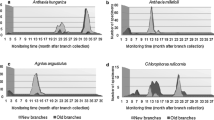Abstract
Hericia sanukiensis (Astigmata: Algophagidae) is a semi-aquatic mite inhabiting fermented sap flux of the Japanese sawtooth oak (Quercus acutissima) and utilizes Nitidulidae (Coleoptera) as the dispersal (phoretic) carrier. Although nitidulid beetles are commonly found in sap flux, the occurrence of H. sanukiensis has been extremely limited to a few trees in Shikoku Island, Kagawa Prefecture, Japan. To elucidate the critical factors limiting the occurrence of this species, we compared several physical and biological characteristics of sap-exudation points, including the structure and temperature of tree trunks, period and abundance of sap exudation, and seasonal occurrence and dispersal behavior of nitidulid beetles between environments with and without mites. During the two consecutive years of field research, we found that only sap-exudation points with obvious tree holes (ringent area >10 cm2, depth >10 cm) had sustained mite populations throughout the observation period. In contrast, for the sap-exudation points lacking tree holes, H. sanukiensis temporally (from spring to autumn) colonized only when the sap production was considerably high. Thus, we suggest that the settlement of H. sanukiensis populations requires tree holes as an overwintering habitat. Nitidulid beetles also concentrated in areas with high sap production and did not disperse from such habitats during the sap flow season. This indicates that H. sanukiensis mites may only disperse and colonize new habitats at very limited opportunities, such as drastic habitat deterioration, which may promote the movement of their carrier. Taken together, these findings may explain the limited occurrence of this mite species.








Similar content being viewed by others
References
Fashing NJ (1994) Life-history patterns of astigmatid inhabitants of water-filled treeholes. In: Houck MA (ed) Mites: ecological and evolutionary analyses of life-history patterns. Chapman and Hall, New York, pp 160–185
Fashing NJ (1998) Functional morphology as an aid in determining trophic behaviour: the placement of astigmatic mites in food webs of water-filled tree-hole communities. Exp Appl Acarol 22:435–453. doi:10.1023/A:1006081622519
Fashing NJ (2002) Nepenthacarus, a new genus of Histiostomatidae (Acari: Astigmata) inhabiting the pitchers of Nepenthes mirabilis (Lour.) Druce in far north Queensland, Australia. Aust J Entomol 41:7–17. doi:10.1046/j.1440-6055.2002.00263.x
Fashing NJ (2004) Biology of Sarraceniopus darlingtoniae (Histiostomatidae: Astigmata) an obligatory inhabitant of the fluid-filled pitchers of Darlingtonia californica (Sarraceniaceae). Phytophaga 14:299–305
Fashing NJ (2008) Biology of the genus Hericia (Algophagidae: Astigmata), with the description of a new species from the eastern United States. Syst Appl Acarol 13:3–25
Fashing NJ, Okabe K (2006) Hericia sanukiensis, a new species of Algophagidae (Astigmata) inhabiting sap flux in Japan. Syst Appl Acarol Spec Publ 22:1–14
Fincke O (1999) Organization of predator assemblages in Neotropical tree holes: effects of abiotic factors and priority. Ecol Entomol 24:13–23
Hayashi K, Ichikawa T, Yasui Y (2010) Life history of the newly discovered Japanese tree sap mite, Hericia sanukiensis (Acari, Astigmata, Algophagidae). Exp Appl Acarol 50:35–49. doi:10.1007/s10493-009-9276-9
Houck MA, Cohen AC (1995) The potential role of phoresy in the evolution of parasitism: radiolabelling (tritium) evidence from an astigmatid mite. Exp Appl Acarol 19:677–694. doi:10.1007/BF00052079
Houck MA, OConnor BM (1991) Ecology and evolutionary significance of phoresy in the Astigmata. Annu Rev Entomol 36:611–636. doi:10.1146/annurev.en.36.010191.003143
Ichikawa T, Ueda K (2009) Predation on exuded sap-dependant arthropods by the larvae of the Oriental carpenter moth, Cossus jezoensis (Matsumura) (Lepidoptera, Cossidae): preliminary observations. Tech Bull Fac Agr Kagawa Univ 62:39–58. in Japanese with English summary
Kingsolver JG (1989) Weather and the population dynamics of insects: integrating physiological and population ecology. Physiol Zool 62:314–334
Kitching RL (2001) Food webs in phytotelmata: “Bottom-up” and “Top-down” explanations for community structure. Annu Rev Entomol 46:729–760
Maguire B (1971) Phytotelmata: biota and community structure determination in plant-held waters. Annu Rev Ecol Syst 2:439–464
Naeem S (1990) Resource heterogeneity and community structure: a case study in Heliconia imbricate phytotelmata. Oecologia 84:29–38. doi:10.1007/BF00665591
OConnor BM (1982) Evolutionary ecology in deutonymphs of astigmatid mite. Annu Rev Entomol 27:385–409. doi:10.1146/annurev.en.27.010182.002125
Okada K, Miyatake T (2007) Librodor japonicus (Coleoptera: Nitidulidae): life history, effect of temperature on development, and seasonal abundance. Appl Entomol Zool (Jpn) 42:411–417. doi:10.1303/aez.2007.411
Ômura H, Honda K, Hayashi N (2000) Identification of feeding attractants in oak sap for adults of two nymphalid butterflies, Kaniska canace and Vanessa indica. Physiol Entomol 25:281–287. doi:10.1046/j.1365-3032.2000.00193.x
Sota T (1996) Effects of capacity on resource input and the aquatic metazoan community structure in phytotelmata. Res Pop Ecol 38:65–73. doi:10.1007/BF02514972
Varga L (1928) Ein interessanter biotop der biocönose von wasserorganismen. Biol Zentralbl 48:143–162
Vepsäläinen K (1978) Coexistence of two competing corixid species (Heteroptera) in an archipelago of temporary rock pools. Oecologia (Berl) 37:177–182
Walter DE, Behan-Pelletier V (1999) Mites in forest canopies: filling the size distribution shortfall? Annu Rev Entomol 44:1–19
Yanoviak SP (2001) The macrofauna of water-filled tree holes on Barro Colorado island, Panama. Biotropica 33:110–120. doi:10.1646/0006-3606(2001)033[0110:TMOWFT]2.0.CO;2
Yoshimoto J, Nisida T (2007) Boring effect of carpenterworms (Lepidoptera: Cossidae) on sap exudation of the oak, Quercus acutissima. Appl Entomol Zool (Jpn) 42:403–410. doi:10.1303/aez.2007.403
Yoshimoto J, Nishida T (2008) Plant-mediated indirect effects of carpenterworms on the insect communities attracted to fermented tree sap. Popul Ecol 50:25–34. doi:10.1007/s10144-007-0063-3
Yoshimoto J, Kakutani T, Nishida T (2005) Influence of resource abundance on the structure of the insect community attracted to fermented tree sap. Ecol Res 20:405–414. doi:10.1007/s11284-005-0054-9
Yoshimoto J, Kakutani T, Nishida T (2007) Do battles lead to coexistence? Role of interference competition in structuring the insect community on fermented tree sap. Ecol Entomol 32:552–558. doi:10.1111/j.1365-2311.2007.00900.x
Acknowledgments
We thank Drs. F. Ito and T. Kobayashi of Kagawa University for valuable suggestions and encouragement during this study. We also thank Dr. K. Okabe of the Forestry and Forest Products Research Institute, Japan in addition to the two anonymous referees for comments on an earlier version of the manuscript.
Author information
Authors and Affiliations
Corresponding author
Rights and permissions
About this article
Cite this article
Hayashi, K., Ichikawa, T. & Yasui, Y. Critical factors in the limited occurrence of the Japanese tree sap mite Hericia sanukiensis (Acari: Astigmata: Algophagidae) inhabiting the sap of the oak Quercus acutissima . Exp Appl Acarol 54, 395–409 (2011). https://doi.org/10.1007/s10493-011-9463-3
Received:
Accepted:
Published:
Issue Date:
DOI: https://doi.org/10.1007/s10493-011-9463-3




